ESP FIAT 500L LIVING 2015 2.G Owner's Manual
[x] Cancel search | Manufacturer: FIAT, Model Year: 2015, Model line: 500L LIVING, Model: FIAT 500L LIVING 2015 2.GPages: 224, PDF Size: 5.92 MB
Page 124 of 224
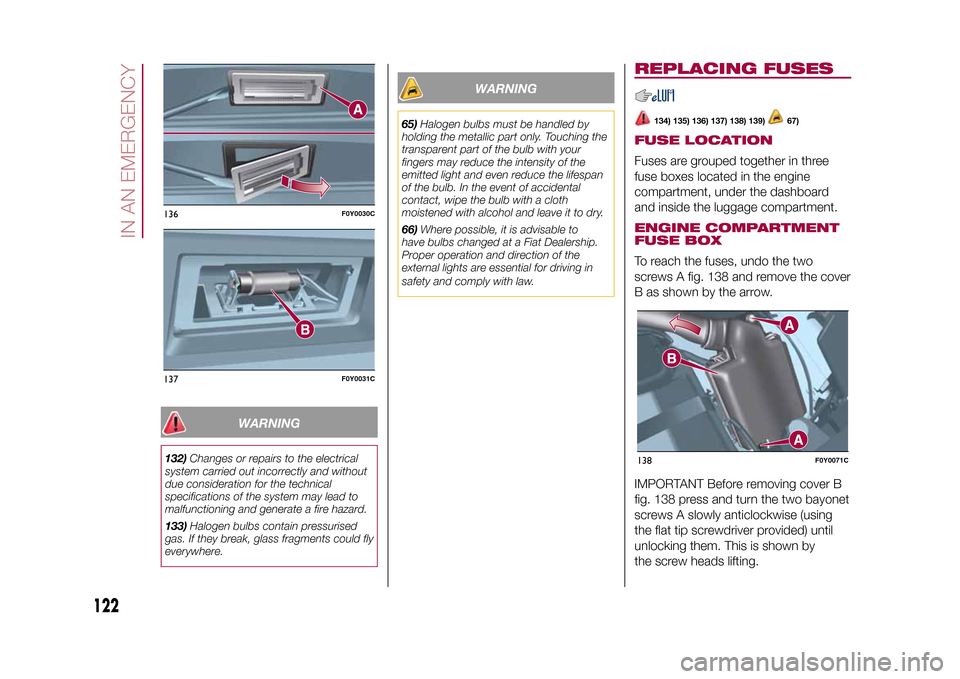
WARNING
132)Changes or repairs to the electrical
system carried out incorrectly and without
due consideration for the technical
specifications of the system may lead to
malfunctioning and generate a fire hazard.
133)Halogen bulbs contain pressurised
gas. If they break, glass fragments could fly
everywhere.
WARNING
65)Halogen bulbs must be handled by
holding the metallic part only. Touching the
transparent part of the bulb with your
fingers may reduce the intensity of the
emitted light and even reduce the lifespan
of the bulb. In the event of accidental
contact, wipe the bulb with a cloth
moistened with alcohol and leave it to dry.
66)Where possible, it is advisable to
have bulbs changed at a Fiat Dealership.
Proper operation and direction of the
external lights are essential for driving in
safety and comply with law.
REPLACING FUSES
134) 135) 136) 137) 138) 139)
67)
FUSE LOCATIONFuses are grouped together in three
fuse boxes located in the engine
compartment, under the dashboard
and inside the luggage compartment.ENGINE COMPARTMENT
FUSE BOXTo reach the fuses, undo the two
screws A fig. 138 and remove the cover
B as shown by the arrow.
IMPORTANT Before removing cover B
fig. 138 press and turn the two bayonet
screws A slowly anticlockwise (using
the flat tip screwdriver provided) until
unlocking them. This is shown by
the screw heads lifting.
136
F0Y0030C
137
F0Y0031C
138
F0Y0071C
122
IN AN EMERGENCY
9-1-2015 12:9 Pagina 122
Page 133 of 224
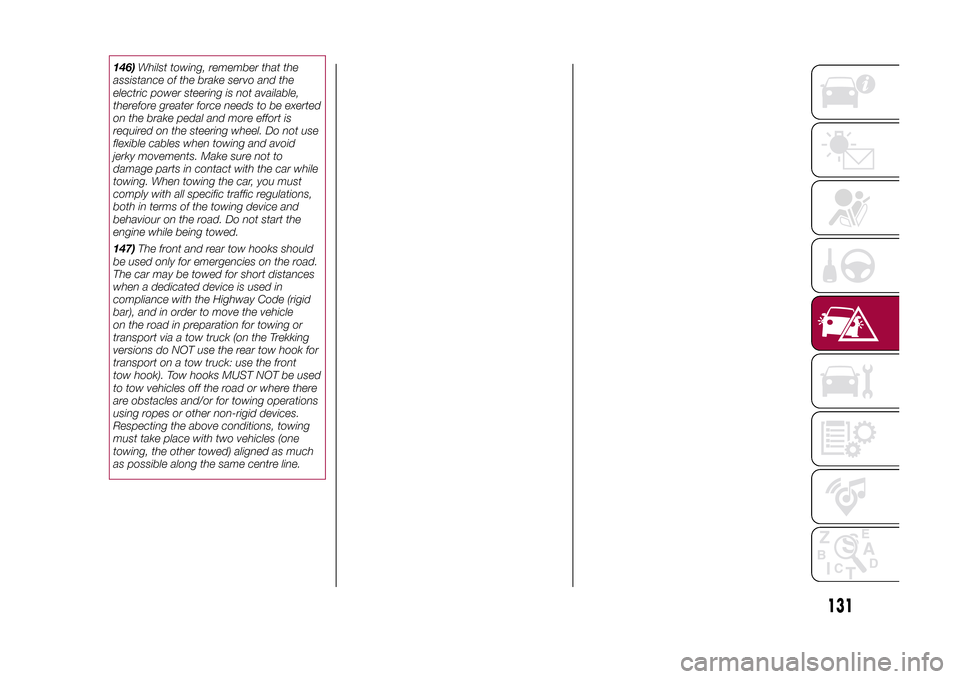
146)Whilst towing, remember that the
assistance of the brake servo and the
electric power steering is not available,
therefore greater force needs to be exerted
on the brake pedal and more effort is
required on the steering wheel. Do not use
flexible cables when towing and avoid
jerky movements. Make sure not to
damage parts in contact with the car while
towing. When towing the car, you must
comply with all specific traffic regulations,
both in terms of the towing device and
behaviour on the road. Do not start the
engine while being towed.
147)The front and rear tow hooks should
be used only for emergencies on the road.
The car may be towed for short distances
when a dedicated device is used in
compliance with the Highway Code (rigid
bar), and in order to move the vehicle
on the road in preparation for towing or
transport via a tow truck (on the Trekking
versions do NOT use the rear tow hook for
transport on a tow truck: use the front
tow hook). Tow hooks MUST NOT be used
to tow vehicles off the road or where there
are obstacles and/or for towing operations
using ropes or other non-rigid devices.
Respecting the above conditions, towing
must take place with two vehicles (one
towing, the other towed) aligned as much
as possible along the same centre line.
131
9-1-2015 12:9 Pagina 131
Page 157 of 224
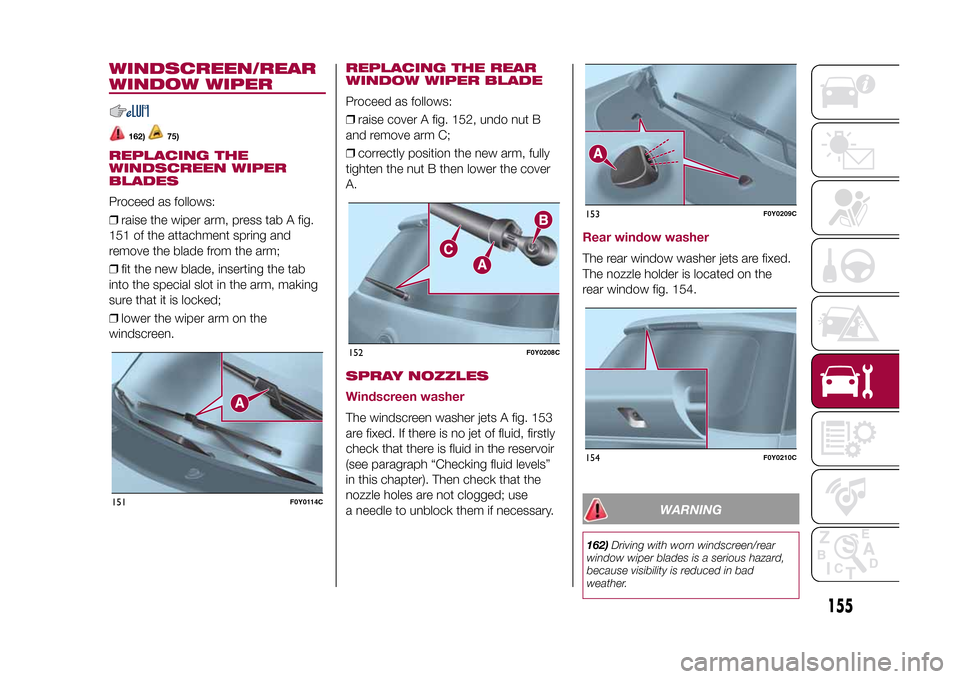
WINDSCREEN/REAR
WINDOW WIPER
162)
75)
REPLACING THE
WINDSCREEN WIPER
BLADESProceed as follows:
❒raise the wiper arm, press tab A fig.
151 of the attachment spring and
remove the blade from the arm;
❒fit the new blade, inserting the tab
into the special slot in the arm, making
sure that it is locked;
❒lower the wiper arm on the
windscreen.
REPLACING THE REAR
WINDOW WIPER BLADEProceed as follows:
❒raise cover A fig. 152, undo nut B
and remove arm C;
❒correctly position the new arm, fully
tighten the nut B then lower the cover
A.SPRAY NOZZLES
Windscreen washerThe windscreen washer jets A fig. 153
are fixed. If there is no jet of fluid, firstly
check that there is fluid in the reservoir
(see paragraph “Checking fluid levels”
in this chapter). Then check that the
nozzle holes are not clogged; use
a needle to unblock them if necessary.
Rear window washerThe rear window washer jets are fixed.
The nozzle holder is located on the
rear window fig. 154.
WARNING
162)Driving with worn windscreen/rear
window wiper blades is a serious hazard,
because visibility is reduced in bad
weather.
151
F0Y0114C
152
F0Y0208C
153
F0Y0209C
154
F0Y0210C
155
9-1-2015 12:9 Pagina 155
Page 162 of 224
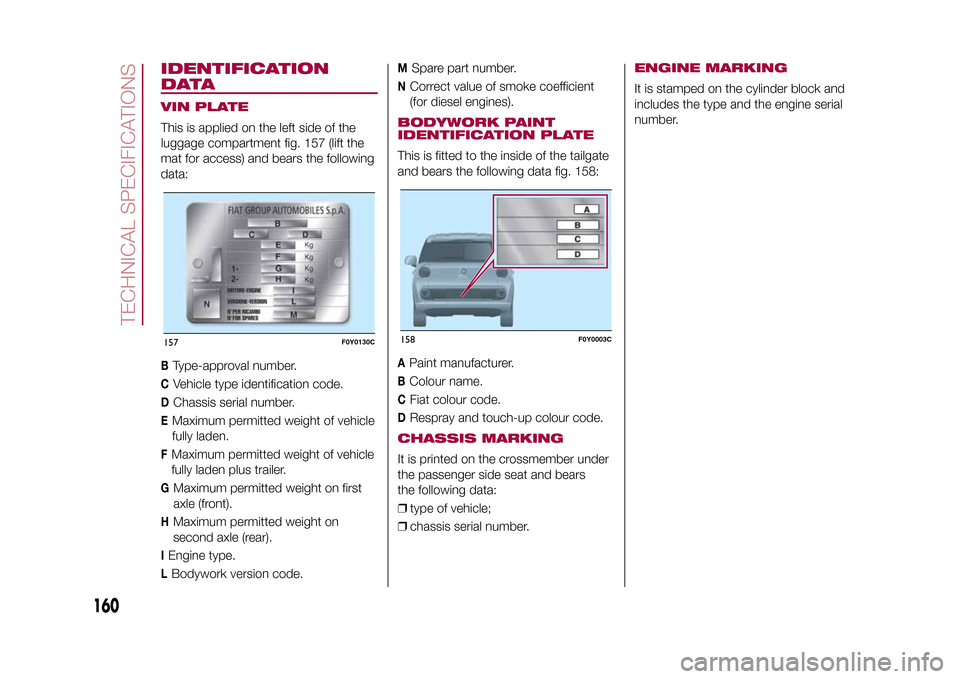
IDENTIFICATION
DATAVIN PLATEThis is applied on the left side of the
luggage compartment fig. 157 (lift the
mat for access) and bears the following
data:B
Type-approval number.
C
Vehicle type identification code.
D
Chassis serial number.
EMaximum permitted weight of vehicle
fully laden.FMaximum permitted weight of vehicle
fully laden plus trailer.G
Maximum permitted weight on first
axle (front).
H
Maximum permitted weight on
second axle (rear).
IEngine type.LBodywork version code.
M
Spare part number.
N
Correct value of smoke coefficient
(for diesel engines).
BODYWORK PAINT
IDENTIFICATION PLATEThis is fitted to the inside of the tailgate
and bears the following data fig. 158:A
Paint manufacturer.
B
Colour name.
C
Fiat colour code.
D
Respray and touch-up colour code.
CHASSIS MARKINGIt is printed on the crossmember under
the passenger side seat and bears
the following data:
❒type of vehicle;
❒chassis serial number.
ENGINE MARKINGIt is stamped on the cylinder block and
includes the type and the engine serial
number.
157
F0Y0130C
158
F0Y0003C
160
TECHNICAL SPECIFICATIONS
9-1-2015 12:9 Pagina 160
Page 163 of 224
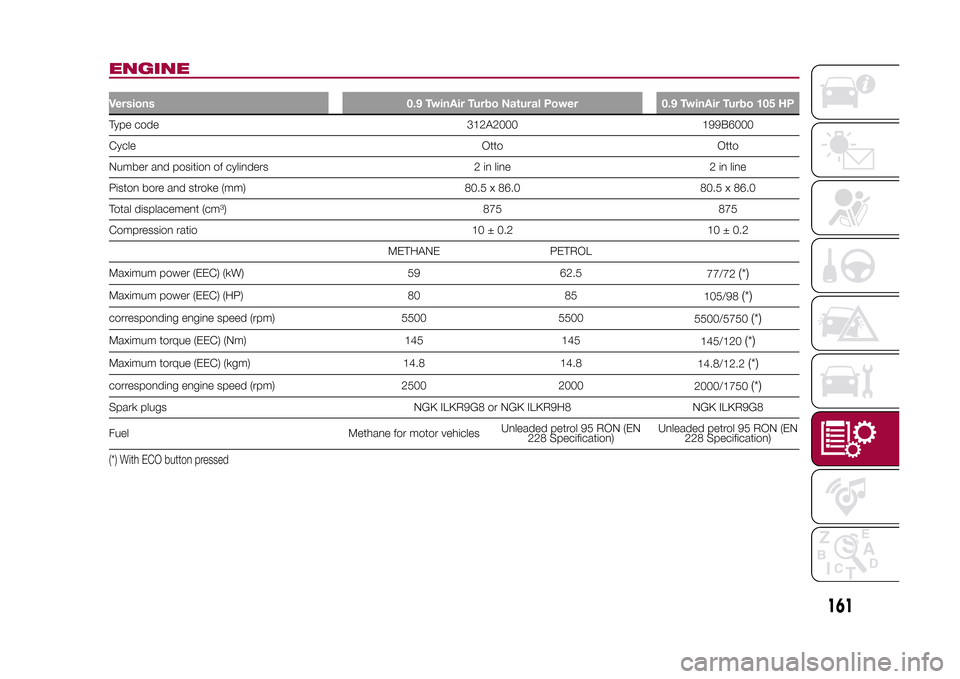
ENGINEVersions 0.9 TwinAir Turbo Natural Power 0.9 TwinAir Turbo 105 HPType code 312A2000 199B6000
Cycle Otto Otto
Number and position of cylinders 2 in line 2 in line
Piston bore and stroke (mm) 80.5 x 86.0 80.5 x 86.0
Total displacement (cm³) 875 875
Compression ratio 10 ± 0.2 10 ± 0.2
METHANE PETROL
Maximum power (EEC) (kW) 59 62.5
77/72
(*)
Maximum power (EEC) (HP) 80 85
105/98
(*)
corresponding engine speed (rpm) 5500 5500
5500/5750
(*)
Maximum torque (EEC) (Nm) 145 145
145/120
(*)
Maximum torque (EEC) (kgm) 14.8 14.8
14.8/12.2
(*)
corresponding engine speed (rpm) 2500 2000
2000/1750
(*)
Spark plugs NGK ILKR9G8 or NGK ILKR9H8 NGK ILKR9G8
Fuel Methane for motor vehiclesUnleaded petrol 95 RON (EN
228 Specification)Unleaded petrol 95 RON (EN
228 Specification)(*) With ECO button pressed
161
9-1-2015 12:9 Pagina 161
Page 164 of 224
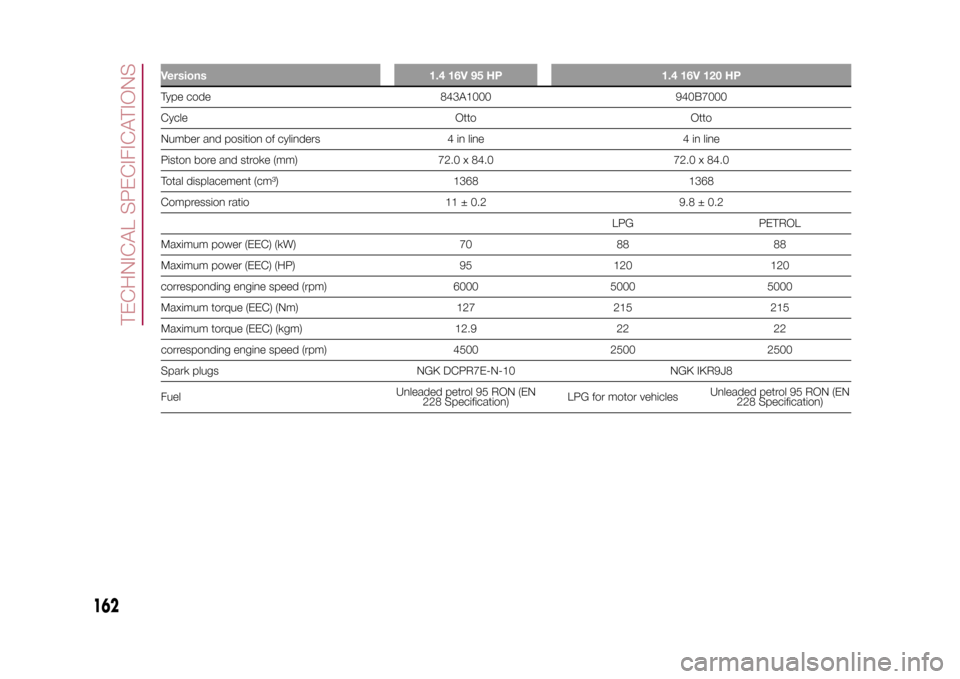
Versions 1.4 16V 95 HP 1.4 16V 120 HPType code 843A1000 940B7000
Cycle Otto Otto
Number and position of cylinders 4 in line 4 in line
Piston bore and stroke (mm) 72.0 x 84.0 72.0 x 84.0
Total displacement (cm³) 1368 1368
Compression ratio 11 ± 0.2 9.8 ± 0.2
LPG PETROL
Maximum power (EEC) (kW) 70 88 88
Maximum power (EEC) (HP) 95 120 120
corresponding engine speed (rpm) 6000 5000 5000
Maximum torque (EEC) (Nm) 127 215 215
Maximum torque (EEC) (kgm) 12.9 22 22
corresponding engine speed (rpm) 4500 2500 2500
Spark plugs NGK DCPR7E-N-10 NGK IKR9J8
FuelUnleaded petrol 95 RON (EN
228 Specification)LPG for motor vehiclesUnleaded petrol 95 RON (EN
228 Specification)
162
TECHNICAL SPECIFICATIONS
9-1-2015 12:9 Pagina 162
Page 165 of 224
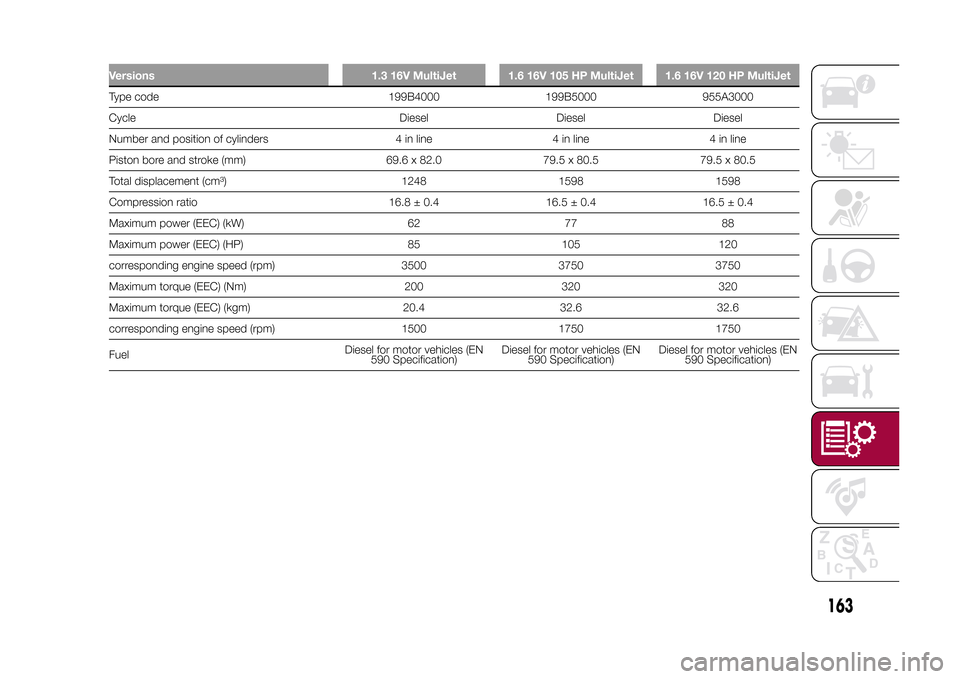
Versions 1.3 16V MultiJet 1.6 16V 105 HP MultiJet 1.6 16V 120 HP MultiJetType code 199B4000 199B5000 955A3000
Cycle Diesel Diesel Diesel
Number and position of cylinders 4 in line 4 in line 4 in line
Piston bore and stroke (mm) 69.6 x 82.0 79.5 x 80.5 79.5 x 80.5
Total displacement (cm³) 1248 1598 1598
Compression ratio 16.8 ± 0.4 16.5 ± 0.4 16.5 ± 0.4
Maximum power (EEC) (kW) 62 77 88
Maximum power (EEC) (HP) 85 105 120
corresponding engine speed (rpm) 3500 3750 3750
Maximum torque (EEC) (Nm) 200 320 320
Maximum torque (EEC) (kgm) 20.4 32.6 32.6
corresponding engine speed (rpm) 1500 1750 1750
FuelDiesel for motor vehicles (EN
590 Specification)Diesel for motor vehicles (EN
590 Specification)Diesel for motor vehicles (EN
590 Specification)
163
9-1-2015 12:9 Pagina 163
Page 177 of 224
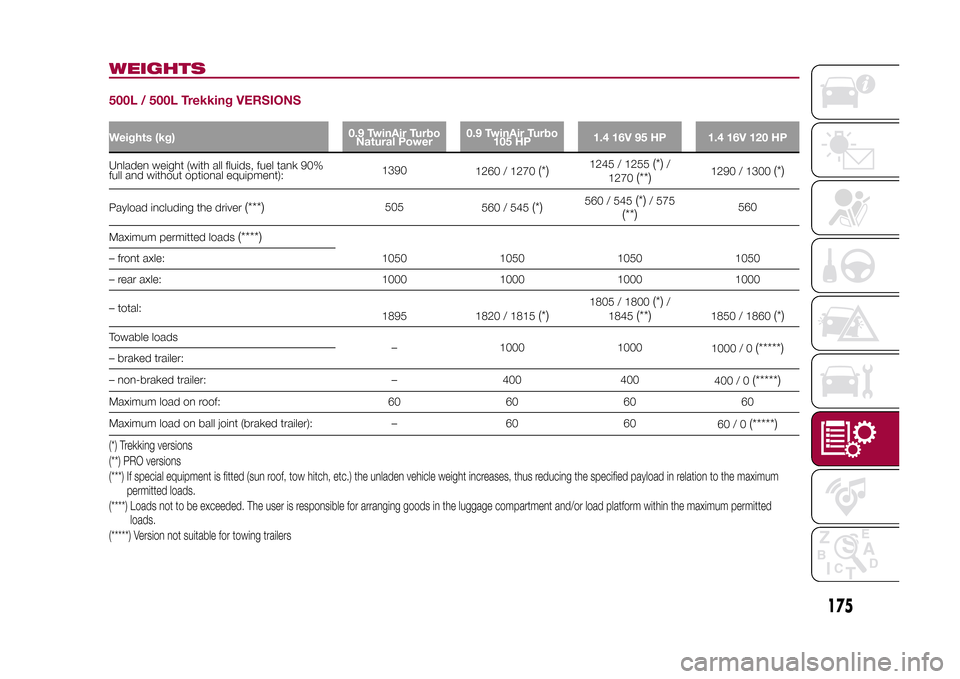
WEIGHTS500L / 500L Trekking VERSIONSWeights (kg)0.9 TwinAir Turbo
Natural Power0.9 TwinAir Turbo
105 HP1.4 16V 95 HP 1.4 16V 120 HPUnladen weight (with all fluids, fuel tank 90%
full and without optional equipment):1390
1260 / 1270
(*)
1245 / 1255
(*)
/
1270
(**)
1290 / 1300
(*)
Payload including the driver
(***)
505
560 / 545
(*)
560 / 545
(*)
/ 575
(**)
560
Maximum permitted loads
(****)
1050 1050 1050 1050 – front axle:
– rear axle: 1000 1000 1000 1000
– total:
1895 1820 / 1815
(*)
1805 / 1800
(*)
/
1845
(**)
1850 / 1860
(*)
Towable loads
– 1000 1000
1000 / 0
(*****)
– braked trailer:
– non-braked trailer: – 400 400
400/0
(*****)
Maximum load on roof: 60 60 60 60
Maximum load on ball joint (braked trailer): – 60 60
60/0
(*****)
(*) Trekking versions
(**) PRO versions
(***) If special equipment is fitted (sun roof, tow hitch, etc.) the unladen vehicle weight increases, thus reducing the specified payload in relation to the maximum
permitted loads.
(****) Loads not to be exceeded. The user is responsible for arranging goods in the luggage compartment and/or load platform within the maximum permitted
loads.
(*****) Version not suitable for towing trailers
175
9-1-2015 12:9 Pagina 175
Page 179 of 224
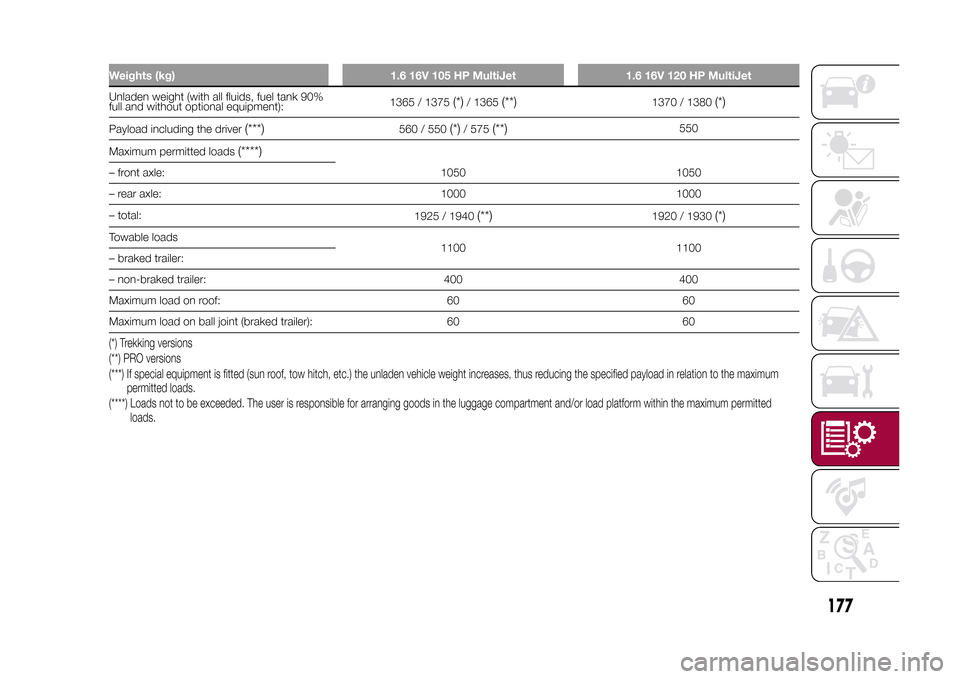
Weights (kg) 1.6 16V 105 HP MultiJet 1.6 16V 120 HP MultiJetUnladen weight (with all fluids, fuel tank 90%
full and without optional equipment):1365 / 1375
(*)
/ 1365
(**)
1370 / 1380
(*)
Payload including the driver
(***)
560 / 550
(*)
/ 575
(**)
550
Maximum permitted loads
(****)
1050 1050 – front axle:
– rear axle: 1000 1000
– total:
1925 / 1940
(**)
1920 / 1930
(*)
Towable loads
1100 1100
– braked trailer:
– non-braked trailer: 400 400
Maximum load on roof: 60 60
Maximum load on ball joint (braked trailer): 60 60(*) Trekking versions
(**) PRO versions
(***) If special equipment is fitted (sun roof, tow hitch, etc.) the unladen vehicle weight increases, thus reducing the specified payload in relation to the maximum
permitted loads.
(****) Loads not to be exceeded. The user is responsible for arranging goods in the luggage compartment and/or load platform within the maximum permitted
loads.
177
9-1-2015 12:9 Pagina 177
Page 180 of 224
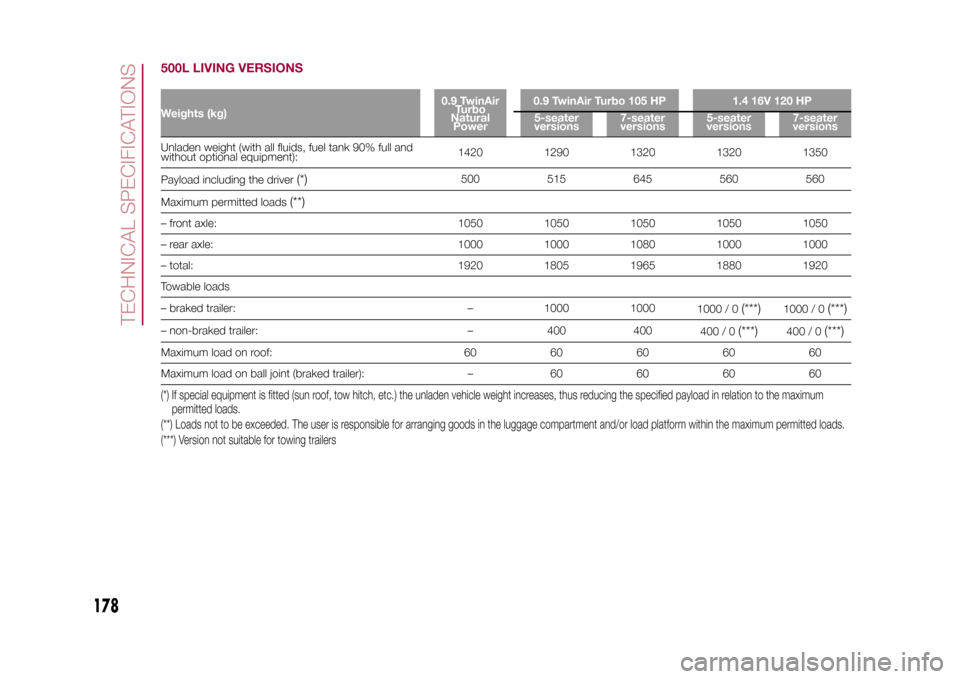
500L LIVING VERSIONSWeights (kg)0.9 TwinAir
Turbo
Natural
Power0.9 TwinAir Turbo 105 HP 1.4 16V 120 HP
5-seater
versions7-seater
versions5-seater
versions7-seater
versionsUnladen weight (with all fluids, fuel tank 90% full and
without optional equipment):1420 1290 1320 1320 1350
Payload including the driver
(*)
500 515 645 560 560
Maximum permitted loads
(**)
– front axle: 1050 1050 1050 1050 1050
– rear axle: 1000 1000 1080 1000 1000
– total: 1920 1805 1965 1880 1920
Towable loads
– braked trailer: – 1000 1000
1000 / 0
(***)
1000 / 0
(***)
– non-braked trailer: – 400 400
400/0
(***)
400/0
(***)
Maximum load on roof: 60 60 60 60 60
Maximum load on ball joint (braked trailer): – 60 60 60 60(*) If special equipment is fitted (sun roof, tow hitch, etc.) the unladen vehicle weight increases, thus reducing the specified payload in relation to the maximum
permitted loads.
(**) Loads not to be exceeded. The user is responsible for arranging goods in the luggage compartment and/or load platform within the maximum permitted loads.
(***) Version not suitable for towing trailers
178
TECHNICAL SPECIFICATIONS
9-1-2015 12:9 Pagina 178